At a recent conference on the convergences and divergences of food cultures – there actually are such funded academic gatherings – I argued that cuisines could vanish. While appearing robust, they are often, in reality, distressingly fragile. For dramatic emphasis I pointed to the remarkable disappearance of classic French cuisine, a cuisine that has gone from dominant to absent in less than half a century. Here was a cuisine that could never die, but did exactly that. Where can one find those wondrously heavy sauces that so admirably contributed to lowering life expectancies among the rich and powerful? The days of roux are done. Do diners dream of mirapoix? Grand restaurants in Paris – and New York – once ladled out the cream and the butter, and every well-made sauce was flour-based: the gluten-or–lactose intolerants were in the closet. Vegans had to live by a code of don’t ask, don’t eat.
Classic French cuisine was the venerated culinary style for over a century – the natural zenith of cuisine. But when it came crashing down with a push from Nouvelle Cuisine, a nudge from Gault-Millau, and a prod from the health police, the collapse of the caloric tower was total. Who cooks Escoffier today?
Some restaurants exist that are classic-lite – La Grenouille in New York is one – but their cuisine, as presented today, would be thin gruel for the beau monde in 1960.
The night the conference adjourned, I found myself in such a restaurant, the double Michelin-starred Comme Chez Soi (“Just Like Home”), that reflects a classical-lite cuisine with all of its loving style and its drawbacks. Comme Chez Soi is a restaurant that abjures the sharp elbows of the contemporary style. Its heart is in the 1890s – along with its splendid Art Nouveau décor - even if the kitchen is producing a more contemporary version of a classical cuisine at which Careme might scoff. This is a restaurant that is run by the fourth generation of the Wynants family, a low country tradition. But it isn’t your granddad’s restaurant, even if it might wish to be. For many decades the restaurant was run by the great Belgian chef Pierre Wynants, and currently the kitchen is managed by his son-in-law Lionel Rigolet. Perhaps it is true that contemporary diners would rise in anger and disgust at the true classics, but such a claim reminds us that there are limits that you are what you eat. Sometimes dishes are unavailable: there are some culinary selves that we can not be.
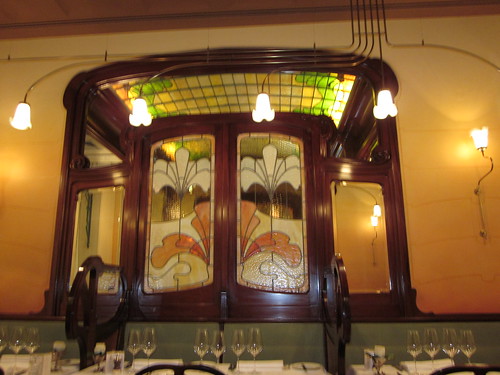
I began with a light amuse of crackers with pink peppercorns, nice and spicy if not particularly daring, and a much more engaging pair of smoked halibut mille-feuilles. The latter were classic in style and conception, but with enough drama and visual appear to keep any contemporary diner sated.

My second amuse was, in fact, a trio: the third, fourth and fifth tastes of the night. The best of the three was a warm geleed fish consommé with microdiced vegetables. Any classic restaurant must be skilled in stock, and Comme Chez Soi shines in the broth department (if broths can be said to have a department). Further, in this one could see the compulsion of the classic restaurant for dicing, mincing, and chopping: mirapoix as religion. I suddenly shuddered to realize that dicing has become a lost art in modern cuisine. When does one find knife skills today? Not often.
Mackerel with cucumber, marinated in yuzu, was also impressive, the only use of fruit on Comme Chez Soi’s menu. And even in Brussels, mackerel has made its mark. Every fish gets its fifteen minutes of fame, and this is mackerel’s turn. The third of the set Fried Crawfish with several dabs of a quasi-Chinese sweet sauce was a disappointing bite, reminding more of little more than a cheap and not very authentic Asian restaurant. Any restaurant that has linen napkins should be very cautious when considering investing in a deep fat fryer: grease does marry graciousness well.
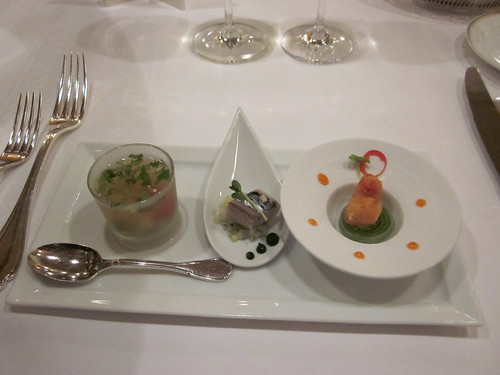
The first post-amuse dish, a carpaccio duet of Dublin bay prawns and lobster with lemongrass and raw minced gambas (shrimp) with ginger and lime, showed off Comme Chez Soi to its best effect. Here was a dish that revealed that mosaics were once a delight of the pampered diner. It was a jigsaw in spirit and in practice. While the lemongrass lent the plate a modern twist, the twist was simultaneously discreet and effective. It was restrained and classic, but very intriguing. CCS is traditional but not embalmed.
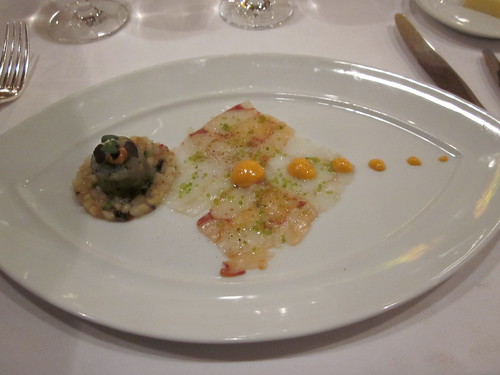
While it is not quite fair to term the second dish a soup, it revealed again the height of broth. I was served steamed dab with snails from Namur, bouillon with shiitake and Chinese chives. The flavors were rich and the presentation restrained. Perhaps the dab was cooked more fully than one would find at Le Bernardin, but it was moist and rich and happy in its little ocean.
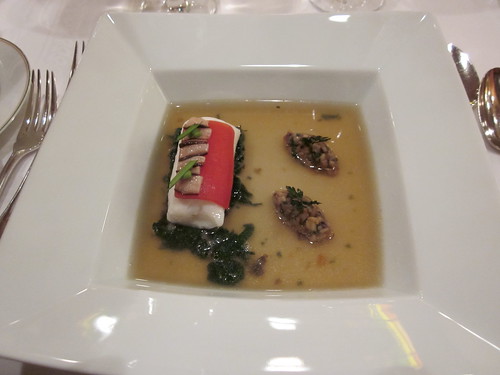
Scallops with Puy lentils and cucumber roll with Colchester flat oysters proved again to be properly restrained in the lite-classicism that I was learning to appreciate. CCS rarely challenges the diner with clashing tastes, and this was certainly true with this subtle dish. To be sure oysters and scallops are not usual partners, but neither are they oysters and blueberries. The restaurant as current style demands provides a dollop of light sauce, a well-made accompaniment.
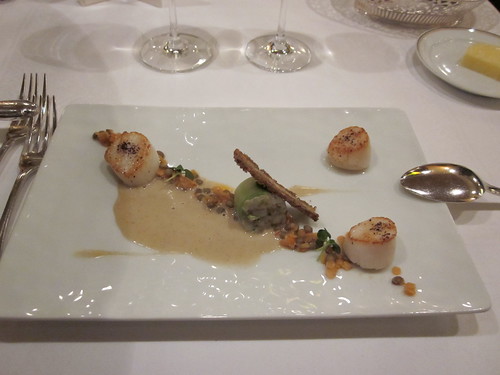
The greatest disappointment of the evening was the main course of roasted halibut with Chiloë peppers and king crab, smoked emulsion of parmesan and old balsamico. Halibut has a strong and “fishy” taste, and can easily be overcooked. By overcooked, I don’t mean inedible, and I did not return the dish, but lacked appeal, even when set off by the balsamic sauce. Visually it was subtle, but lacked a spark on the keyboard of taste.
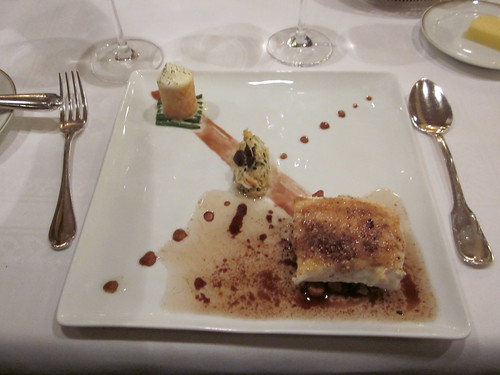
The first dessert, “pear with multiple flavors,” was close to the contemporary style with a set of plated thematic mini-desserts. I particularly enjoyed the pear ice cream and “Poire William” soup with its brandied kick. While it was not as startling or as deconstructed as a fully modernist dessert, it revealed the possibilities of pear.
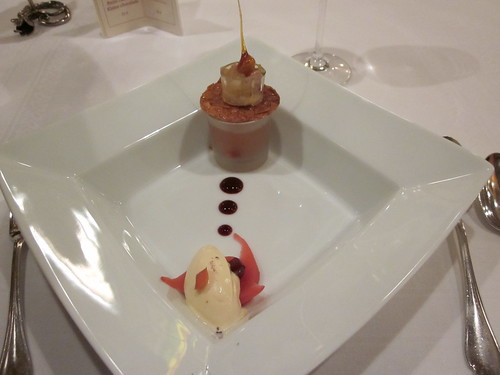
The final scheduled dessert emphasized chocolate and coffee, but as I avoid caffeine, I pleaded for a fruity exchange, and I was graciously blessed with the highpoint of the evening: a fully classic Lime Soufflé with Lime Sorbet. Nothing adventuresome. Just a perfect presentation of a canonical dish. Yum. When done right, the oldies are still goldies.
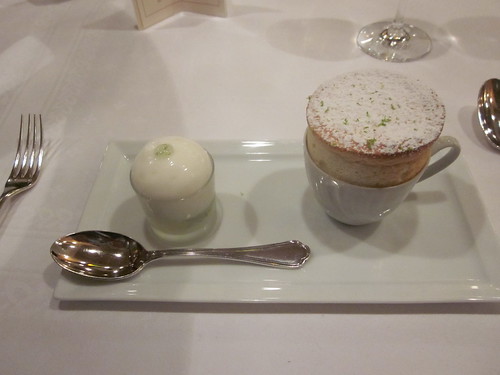
Given current styles, it is hard to suggest that Comme Chez Soi is an essential restaurant. Yet, I would mourn if it disappeared. In its restrained classicism, served in a striking Art Nouveau dining room, it is graceful and loving. Perhaps the main course disappointed, but most of the dinner captivated me, revealing the pleasures of restaurants from the days when I started my trek through the culinary forests. But, I wonder, could a restaurant in thrall to Escoffier survive the footfalls of modernism? Can a restaurant, in sympathy with anthropologist Bruno Latour, shout that “we are not modern” and survive?
Comme Chez Soi
Place Rouppe 23
Brussels, Belgium
02-512-29-21
http://www.commechezsoi.be/

No comments:
Post a Comment